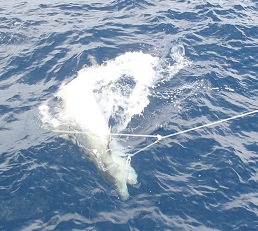NOAA Teacher at Sea
Britta Culbertson
Aboard NOAA Ship Oscar Dyson
September 4-19, 2013
Mission: Juvenile Walley Pollock and Forage Fish Survey
Geographical Area of Cruise: Gulf of Alaska
Date: Wednesday, August 28, 2013
My name is Britta Culbertsonand I am currently serving as anAlbert Einstein Distinguished Educator Fellow in Washington, DC. Prior to my fellowship, I was a high school science and art teacher in Seattle, Washington at The Center School. I am serving my fellowship in NOAA’s Office of Education and have spent the last year getting exposed to many aspects of NOAA’s education efforts.
Einstein Fellows are K-12 science, technology, engineering, or math (STEM) educators who come from all over the United States after a competitive selection process to serve in federal agencies or on Capitol Hill. They typically serve for the duration of one school year. Fortunately, I was offered to stay one more year in my office and will complete my second year in July 2014. Through my role as an Einstein Fellow, I have been able share NOAA resources with teachers at national conferences, work on the education website, and network with a community of STEM professionals in Washington, D.C. among other things. One task that I hope to accomplish this year is figuring out a way to make real-time NOAA datasets more accessible to teachers.
I am really excited about the opportunity to be a NOAA Teacher at Sea to learn more about the fisheries research conducted by NOAA scientists and to see if there might be opportunities to share real data from my cruise with students and their teachers.
After spending a year meeting Teacher at Sea alumni and hearing about their experiences, I am overjoyed to embark on my own cruise and to have a chance to work with scientists in the field. I think these real-life experiences are crucial for teachers because it allows them get in touch with the scientific process in the field as opposed to the artificial environment in which we conduct experiments in the classroom. Sharing these real-life research experiences with students is vital to their understanding of science.
I spent part of my summer in Greenland working with high school students from Denmark, Greenland, and the United States. During my three weeks there, I was inspired by the way the students were more interested in the research they conducted. Being in the field made it more relevant and the students were more engaged. We had visual teleconferences with scientists who were studying climate change and also worked with scientists who were in Greenland conducting research. It was such a phenomenal experience for everyone involved. I wish to use this trip as a model for my future classroom experiences and I am hoping that some of the scientists on my cruise might be willing to stay in touch with me and my students in the future. Not only do I wish to incorporate more “real world” experiences and data into my science teaching, but I hope to connect more students with scientists.
I will be departing Washington, D.C. on September 2 and will travel via Seattle and Anchorage to reach my final destination in Kodiak, Alaska. I will board NOAA’s ship the Oscar Dyson on September 4 at port in Kodiak. From Kodiak, we will head into the Gulf of Alaska and eventually make our way toward Prince William Sound, which incidentally, was the site of the disastrous Exxon Valdez oil spill in 1989. During the cruise, we will be collecting and studying walleye pollock. If you’ve ever eaten fish sticks or imitation crabmeat, you were most likely eating pollock! According to NOAA’s Fishwatch.gov, “The Alaska pollock fishery is one of the largest, most valuable fisheries in the world.”
Our cruise has several objectives ranging from the study of walleye pollock to physical and chemical oceanography. I’m also excited about one aspect of the cruise, which is a gear comparison to examine the catch differences for each species between the anchovy trawl and the CamTrawl. We will also be describing the community structure, biomass, and vitality of the other swimming, aquatic organisms we capture along with pollock. These organisms include capelin, eulachon, Pacific cod, arrowtooth flounder, sablefish, and rockfish. Additionally, we will examine species that typically prey upon pollock and we will measure the environmental variables that could affect pollock ecology.
It was a wonderful coincidence that I happened to be in Washington State visiting the Olympic Coast National Marine Sanctuary (OCNMS) the NOAA Alaska Fisheries Science Center when the science team for my cruise had their pre-cruise meeting. I was able to attend in person and meet the scientists with whom I will spend the next three weeks. I am really looking forward to working with them! Visiting the OCNMS was a special treat before my upcoming cruise. It was pretty awesome to stand along the Olympic Coast and check out all of the tide pools and other things like the huge whale skeleton I found. In a few days instead of being on the edge of this massive ocean, I’ll be on a boat discovering what is in the depths of the same ocean. I’m looking forward to leaving the hot and humid D.C. weather behind for the cooler weather in Kodiak. Next time you hear from me, I’ll be a teacher at sea!
















































































